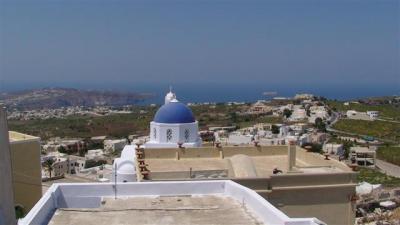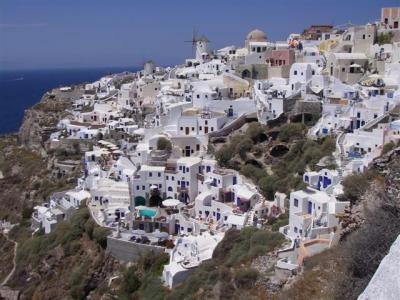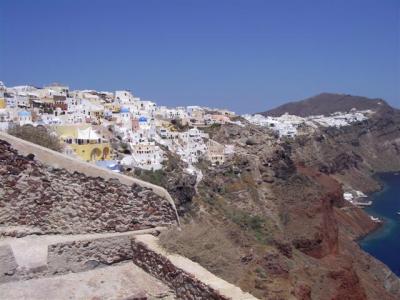Continued from yesterday… As we marched along like ants in a line, we thought about how terrible it must be for the locals to have their town overtaken every day by hundreds of tourists that try to look in their doors and windows. We wonder if many people even live there, or if they have abandoned the historic areas for more modern ones. Let’s face it, who wants to park their car at the bottom of a mountain and lug their heavy groceries all the way up the hill? Wouldn’t you want a house built on a road where you can pull up to the front door?
At the top of the hill, the view is stunning. It is one of the highest peaks on the islands. We enjoyed the view and took some photos, and then it was already time to head back down. Progress down was as slow as progress up.

We piled back into the bus and headed to Oia, at the north end of the island. This is the town that Santorini is famous for. 80% of the Santorini photos you see come from Oia. Uh oh. There were even more busses in this parking lot than the last one. Our group swarmed up the mountain to the old Venetian portion of the town, joining the sea of people already filling the narrow streets. This town is definitely super scenic. It was largely destroyed in an earthquake in 1956, and for a couple decades was a ghost town until people came back and started rebuilding. There are only a few historic buildings left, but the layout of the old area looks to be the same as before the earthquake. Like Pirgos, the walkways are narrow mazes tracking up and down the cliff. The buildings are tightly packed into one another with no wasted space, but the lay out wasn’t as quite as odd as in Pirgos. You could definitely distinguish buildings from one another. We suspect today’s building regulations have something to do with the buildings being more “regular” looking. Most of the buildings are attractive, all looking quite similar in style. There are a lot of churches with the blue dome here, as well. And, despite the more modern buildings, there are still a lot of doors that seemed to go to nowhere. We began to wonder if there are caves is these cliffs that people live in. That would explain some of the doors to nowhere.
We headed down to the old Venetian fort. There isn’t much left there, just a few walls and an open area that once contained the fort. Here is a shot of the fort from above. As you can see, there is a nice view of the islands in the caldera. The second shot is looking north from the fort. If you look carefully, you can see the narrow, maze like walkways. The third is looking north from the fort.



We headed over to the windmills, wondering Continue reading →
